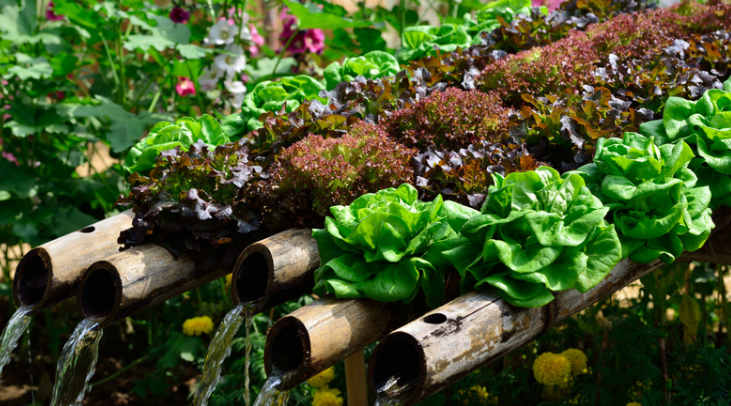In today’s world where water scarcity is an increasingly serious issue, it is important to find sustainable ways to conserve water. Hydroponics, an innovative agricultural method for growing plants without soil, offers a promising solution to this global problem. By harnessing the power of water-saving technologies, hydroponics not only revolutionizes agriculture but also contributes greatly to the conservation of one of our most precious resources: water.
What is Hydroponics?
Hydroponics is a soil-free method of growing plants that uses water-based nutrient solutions to deliver essential minerals and elements directly to the plant’s roots. This method is becoming increasingly popular because it allows food to be grown in environments where traditional soil-based agriculture is not practical, such as urban areas, greenhouses, or areas with arid climates. A key advantage of hydroponics is its water efficiency. Unlike traditional agriculture, where much of the irrigation water is lost through evaporation, runoff, or absorption by the soil, hydroponic systems are designed to continually recycle water, making them much more water-efficient.
Why hydroponics is a water-saving game changer
1. Closed-loop system
One of the key principles of hydroponics is the closed-loop system. This means that the need for regular water refills is reduced, as the water circulates through the system. The water used in hydroponic systems is often stored in a reservoir, from where it is pumped to the plants’ roots, then collected again for reuse. This allows hydroponic systems to use up to 90% less water than traditional farming methods.
2. Less Water Loss
In traditional agriculture, much of the water used for irrigation is lost through evaporation, especially in dry climates. Hydroponic systems, especially those using technologies such as Nutrient Film Technology (NFT) and aeroponics, minimize water-air contact and greatly reduce evaporation rates, making them particularly well-suited for water-scarce areas.
3. Efficient Nutrient Delivery
With hydroponics, water and nutrients are released directly to the roots in a controlled manner so plants get exactly what they need, when they need it. This precision reduces waste because nutrients and water are not overdosed or allowed to seep into the surrounding soil, as often occurs with traditional irrigation.
4. Reduced Runoff and Pollution
Traditional agriculture often results in runoff, where excess water washes away nutrients as well as pesticides, herbicides and fertilizers, which can pollute nearby waterways. Hydroponics, on the other hand, offers a cleaner, more sustainable alternative that significantly reduces the risk of runoff and minimizes damage to the environment.
5. Adaptability to Arid Regions
Hydroponic systems make it possible to grow food in places with limited access to water. In areas with scarce freshwater resources or poor soil quality, hydroponics can be a viable way to grow crops without depleting the water reserves of the surrounding environment. In fact, hydroponic farms have been established in desert regions such as the Middle East, where saltwater or recycled water is used for cultivation.
Main types of hydroponic systems that improve water conservation
1. Deep Water Culture (DWC):
In this system, plants are suspended in a nutrient-rich aqueous solution and their roots are directly immersed in the liquid. The water is continuously aerated to provide oxygen to the roots. The system reduces water waste as the nutrient solution circulates and evaporation is minimized due to the closed container.
2. Nutrient Film Technology (NFT):
NFT systems contain a thin film of nutrient solution that flows over the plant roots, allowing the plant roots to absorb nutrients and oxygen without being submerged. Since water is constantly recycled in a closed system, this technology significantly reduces water usage compared to traditional agriculture.
3. Wick System:
The Wick System is a simpler passive hydroponic technique that allows water from a reservoir to flow through a wick into the growing medium. This system requires less water and is easy to implement on a small scale, making it ideal for home gardens and small-scale agriculture.
4. Aeroponics:
Aeroponics suspends the roots of plants in the air and sprays them with a nutrient solution. This system can be timed to spray only the amount the plants need, using very little water, with near-zero waste and maximum efficiency.
Benefits beyond water savings
While the biggest benefit of hydroponic growing is water savings, this growing method also has several other environmental and economic benefits: –
- **Space efficiency**: Hydroponic systems can be stacked vertically or vertically. They can be installed in tight spaces, making them ideal for urban agriculture and indoor growing. –
- **Faster plant growth**: Because plants in a hydroponic system do not have to compete for nutrients in the soil, they often grow faster, allowing for quicker harvests and higher yields per square meter.
- **Less pesticide use**: Because hydroponic plants are grown in a controlled environment, they are less susceptible to pests and diseases, reducing the need for chemical pesticides.
Challenges and considerations
Despite its many advantages, hydroponic growing also comes with its own challenges. The initial setup costs for a hydroponic system can be high, especially for large scale operations. In addition, maintaining the proper nutrient balance and monitoring water quality requires a certain level of technical expertise. However, with technological advances and the increasing use of hydroponics, these challenges are gradually being overcome.
Hydroponics offers a sustainable, water-saving alternative to traditional agricultural practices. As water scarcity becomes a growing global issue, this innovative farming method is a key solution to reduce water consumption while ensuring an abundant food supply. In both arid and urban areas, hydroponics can help build more resilient food systems – systems that use less water, increase yields, and preserve precious natural resources for future generations.

